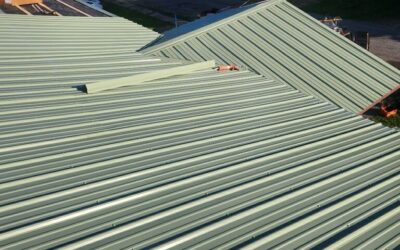Roof Lightning Protection Systems for Industrial and Commercial Buildings
When it comes to protecting commercial and industrial buildings, many property owners focus on structural integrity, HVAC efficiency, and waterproofing—but one critical component that is often overlooked is lightning protection. A single lightning strike can cause catastrophic damage to a building, leading to fires, electrical surges, loss of valuable equipment, and even putting lives at risk. That’s why roof lightning protection systems are an essential part of any comprehensive building safety strategy.
In this blog, we’ll take a deep dive into the importance of lightning protection systems for commercial and industrial properties, how they work, and what factors to consider when installing one.
Table of Contents:
- Why Lightning Protection Matters
- How Lightning Affects Industrial and Commercial Buildings
- What is a Roof Lightning Protection System?
- Components of a Lightning Protection System
- Types of Roof Lightning Protection Systems
- Key Standards and Code Compliance
- Industries That Need Lightning Protection Most
- Benefits of Installing a Lightning Protection System
- Risks of Not Having Protection in Place
- Installation Considerations for Commercial Roofs
- Maintenance and Inspection Requirements
- How to Choose the Right Installer
- S&K Construction and Remodeling LLC – Industrial Roofing Experts
- Get a Free Estimate and Protect Your Facility Today
1. Why Lightning Protection Matters
Lightning strikes are more common than many think. The National Weather Service reports that the U.S. experiences over 20 million cloud-to-ground lightning strikes each year. Industrial facilities, warehouses, and commercial high-rises are especially vulnerable due to their size and height.
2. How Lightning Affects Industrial and Commercial Buildings
A direct lightning strike can:
- Start fires in roofing materials
- Cause power surges that fry expensive electrical equipment
- Disrupt operations and safety systems
- Create structural damage
- Void warranties on equipment or infrastructure
3. What is a Roof Lightning Protection System?
A roof lightning protection system is a network of components installed on a building’s roof and exterior. Its purpose is to safely channel the electrical energy from a lightning strike down into the ground, avoiding damage to the structure.
4. Components of a Lightning Protection System
A typical system includes:
- Air Terminals (Lightning Rods): Installed at the highest points to attract lightning.
- Conductors: Cables that direct the electrical current safely.
- Ground Electrodes: Rods or plates buried in the earth to disperse the energy.
- Bonds and Clamps: Ensure all metal systems on the building are interconnected.
5. Types of Roof Lightning Protection Systems
- Franklin Rod System (Traditional): Uses strategically placed rods and conductors.
- Charge Transfer System (CTS): Designed to reduce the electrical field that triggers lightning.
- Early Streamer Emission (ESE): Promotes early connection with the descending lightning leader.
6. Key Standards and Code Compliance
Compliance with the following standards is essential:
- NFPA 780 (National Fire Protection Association)
- UL 96A (Underwriters Laboratories)
- IEEE Standards
- Local and state building codes
7. Industries That Need Lightning Protection Most
- Manufacturing Plants
- Warehouses and Distribution Centers
- Hospitals and Medical Facilities
- Schools and Universities
- Data Centers
- Telecommunication Towers
8. Benefits of Installing a Lightning Protection System
- Prevents fire hazards
- Protects sensitive electronics and communications systems
- Reduces insurance premiums
- Ensures code compliance
- Boosts building valuation
- Protects human life and safety
9. Risks of Not Having Protection in Place
- Equipment damage and downtime
- Injury or death to occupants
- Voided insurance claims
- Costly fire damage
- Potential lawsuits and liability issues
10. Installation Considerations for Commercial Roofs
- Roofing Material Compatibility (metal, membrane, asphalt, etc.)
- Height and Structure Complexity
- Weather Conditions
- Coordination with Other Contractors
11. Maintenance and Inspection Requirements
Like all systems, lightning protection needs periodic inspection:
- After severe storms or roofing work
- Annually by a certified inspector
- Ensure ground continuity and corrosion-free connectors
12. How to Choose the Right Installer
Look for installers who:
- Are UL-listed and NFPA-certified
- Provide documentation for insurance and code compliance
- Have experience with commercial and industrial buildings
- Offer maintenance services
13. S&K Construction and Remodeling LLC – Industrial Roofing Experts
At S&K Construction and Remodeling LLC, we specialize in roofing for commercial and industrial buildings across Northeast Ohio, including Youngstown, Beachwood, Chagrin Falls, Medina, Twinsburg, and beyond. As part of our industrial roof installations, we coordinate with certified lightning protection system professionals to ensure your facility meets all safety and code standards.
We work with trusted partners and provide detailed documentation for your insurance and compliance records. Protect your assets with professional, code-compliant installation.
14. Get a Free Estimate and Protect Your Facility Today
Don’t wait for disaster to strike. Secure your commercial building today with expert roofing and lightning protection services from S&K Construction and Remodeling LLC. Visit www.skroofingandconstruction.com to schedule your FREE estimate. Financing available—most commercial roofs can be financed with flexible terms tailored to your budget.
S&K Construction and Remodeling LLC “Quality You Can Trust, Service You Deserve.” Your partners in industrial and commercial roof safety.
 (440) 307-2060
(440) 307-2060


